Evaluation of Subsidy Programmes
This research group develops the scientific foundations for causal impact analysis of policy interventions within the European Union, with a particular focus on place-based policies. Despite significant public spending on such programmes in many developed economies, there is limited evidence on their effectiveness and efficiency.
Our approach integrates three key dimensions: first, the systematic use of administrative funding data and legislative documents; second, the application of advanced methods in policy impact evaluation; and third, the exchange of knowledge among researchers, policymakers, public administration, and civil society. Without this integration, research risks becoming either overly abstract or disconnected from the institutional and legal realities of policy implementation. By combining these elements, we create robust research designs grounded in real data and legal frameworks.
This approach allows us to generate evidence-based insights that contribute to better informed decision-making—not only in politics but also within civil society. The findings of our work have contributed to the revision and improvement of existing subsidy programmes. The research group is closely embedded in the activities of the Centre for Evidence-based Policy Advice (CEP), ensuring both scientific rigor and practical relevance. In doing so, we embody the leitmotif of the Leibniz Association: theoria cum praxi.
Research Cluster
Economic Dynamics and StabilityYour contact

- Department Centre for Evidence-based Policy Advice
EXTERNAL FUNDING
09.2019 ‐ 09.2022
Establishing Evidence-based Evaluation Methods for Subsidy Programmes in Germany (EVA-KULT)
The project aims at expanding the Centre for Evidence-based Policy Advice at the Halle Institute for Economic Research (IWH-CEP).
01.2018 ‐ 12.2020
Networked growth - Innovative Saxony-Anhalt through digital business models (Competence Center 4.0)
01.2017 ‐ 12.2018
Political Participation in Eastern Germany
12.2015 ‐ 11.2018
Socio-economic Effects of Research on Innovative Approaches for POC Diagnostics
Part of the EXASENS project. Coordinated by the Leibniz Institute of Photonic Technology (IPHT) in Jena, nine Leibniz institutes are working together on researching point-of-care (POC) technology for the prediction and diagnosis of chronic inflammatory respiratory diseases. See press release.
02.2017 ‐ 02.2018
The Importance of Non-University Research Institutions for the Development of Firms and Regions (Be_For_Reg-Projekt)
01.2015 ‐ 12.2016
Evaluation of the "Joint Task 'Improving the Regional Economic Structure'" in the Federal State of Saxony-Anhalt
Refereed Publications
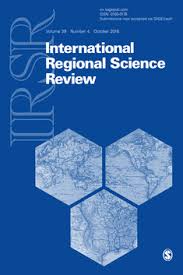
Joint R&D Subsidies, Related Variety, and Regional Innovation
in: International Regional Science Review, No. 3, 2017
Abstract
Subsidies for research and development (R&D) are an important tool of public R&D policy, which motivates extensive scientific analyses and evaluations. This article adds to this literature by arguing that the effects of R&D subsidies go beyond the extension of organizations’ monetary resources invested into R&D. It is argued that collaboration induced by subsidized joint R&D projects yield significant effects that are missed in traditional analyses. An empirical study on the level of German labor market regions substantiates this claim, showing that collaborative R&D subsidies impact regions’ innovation growth when providing access to related variety and embedding regions into central positions in cross-regional knowledge networks.
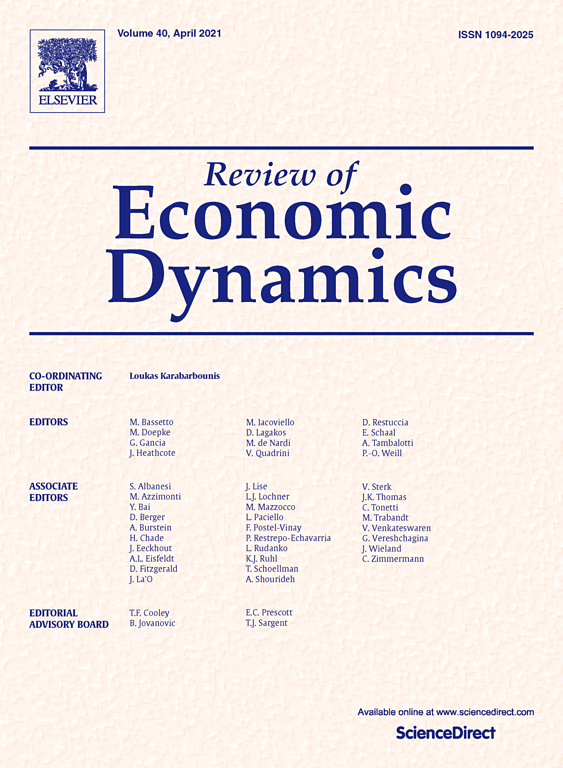
Complex-task Biased Technological Change and the Labor Market
in: Review of Economic Dynamics, April 2017
Abstract
In this paper we study the relationship between task complexity and the occupational wage- and employment structure. Complex tasks are defined as those requiring higher-order skills, such as the ability to abstract, solve problems, make decisions, or communicate effectively. We measure the task complexity of an occupation by performing Principal Component Analysis on a broad set of occupational descriptors in the Occupational Information Network (O*NET) data. We establish four main empirical facts for the U.S. over the 1980–2005 time period that are robust to the inclusion of a detailed set of controls, subsamples, and levels of aggregation: (1) There is a positive relationship across occupations between task complexity and wages and wage growth; (2) Conditional on task complexity, routine-intensity of an occupation is not a significant predictor of wage growth and wage levels; (3) Labor has reallocated from less complex to more complex occupations over time; (4) Within groups of occupations with similar task complexity labor has reallocated to non-routine occupations over time. We then formulate a model of Complex-Task Biased Technological Change with heterogeneous skills and show analytically that it can rationalize these facts. We conclude that workers in non-routine occupations with low ability of solving complex tasks are not shielded from the labor market effects of automatization.
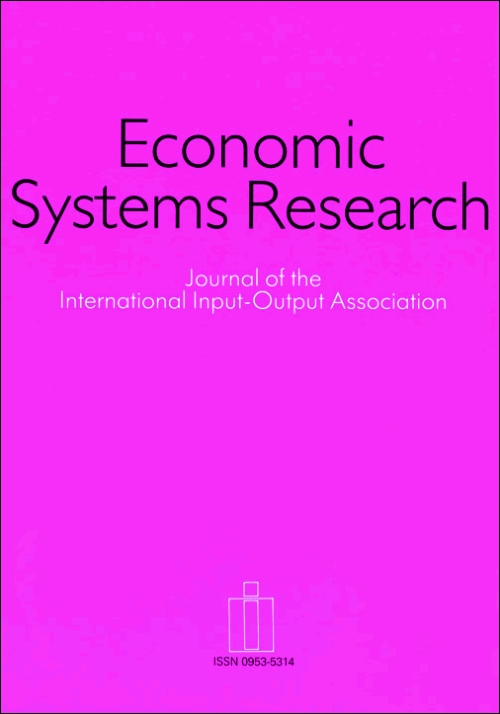
Mapping Potentials for Input-Output Based Innovation Flows in Industrial Clusters – An Application to Germany
in: Economic Systems Research, No. 4, 2016
Abstract
Our paper pursues two aims: first, it presents an approach based on input–output innovation flow matrices to study intersectoral innovation flows within industrial clusters. Second, we apply this approach to the identification of structural weaknesses in East Germany relative to the western part of the country. The case of East Germany forms an interesting subject because while its convergence process after unification began promisingly in the first half of the 1990s, convergence has since slowed down. The existing gap can now be traced mainly to structural weaknesses in the East German economy, such as the absence of strong industrial cluster structures. With this in mind, we investigate whether East Germany does in fact reveal the abovementioned structural weaknesses. Does East Germany possess fewer industrial clusters? Are they less connected? Does East Germany lack specific clusters that are also important for the non-clustered part of the economy?
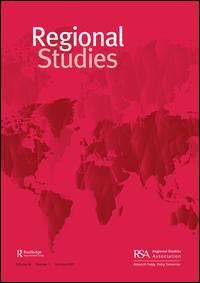
The Importance of Localized Related Variety for International Diversification of Corporate Technology
in: Regional Studies, No. 10, 2016
Abstract
Die Bedeutung der lokalisierten verbundenen Vielfalt für die internationale Diversifizierung von Unternehmenstechnik. Die Internationalisierung der Forschung und Entwicklung hat sich in den letzten Jahren erheblich verstärkt. In diesem Beitrag analysieren wir die Determinanten der räumlichen Verteilung von ausländischen Technikaktivitäten in 96 deutschen Regionen. Zur Identifizierung ausländischer Technikaktivitäten wird das Konzept des grenzübergreifenden Eigentums auf Patentanträge angewandt. Die wichtigste Prämisse lautet, dass Regionen mit einer höheren verbundenen Vielfalt von Technikaktivitäten zwischen den einzelnen Sektoren mehr ausländische Technikaktivitäten anziehen. Aus den Schätzungen geht hervor, dass dies auf Regionen zutrifft, die sich durch ein hohes Maß an genereller technischer Stärke auszeichnen. Dies lässt darauf schließen, dass verbundene Vielfalt die technische Diversifizierung von ausländischen Unternehmen in Regionen an der Spitze der geografischen Hierarchie begünstigt.

Burdett–Mortensen Model of on-the-Job Search with Two Sectors
in: Review of Economic Dynamics, Special Issue in Honor of Dale Mortensen 2016
Abstract
The focus of this paper is on the steady state of a two-sector economy with undirected search where employed and unemployed workers can search for jobs, both within a sector and between the sectors. As in the one-sector model, on-the-job search generates wage dispersion among homogeneous workers. The analysis of the two-sector model uncovers a property called constant tension that is responsible for analytical tractability. We characterize the steady state in all cases with constant tension. When time discounting vanishes, constant tension yields the endogenous separation rate in each sector as a linear function of the present value for a worker. The one-sector economy automatically satisfies constant tension, in which case the linear separation rate implies that equilibrium offers of the worker value are uniformly distributed. Constant tension also has strong predictions for worker transitions and value/wage dispersion, both within a sector and between the two sectors. When constant tension does not hold, we compute the steady state numerically and illustrate its properties.
Working Papers
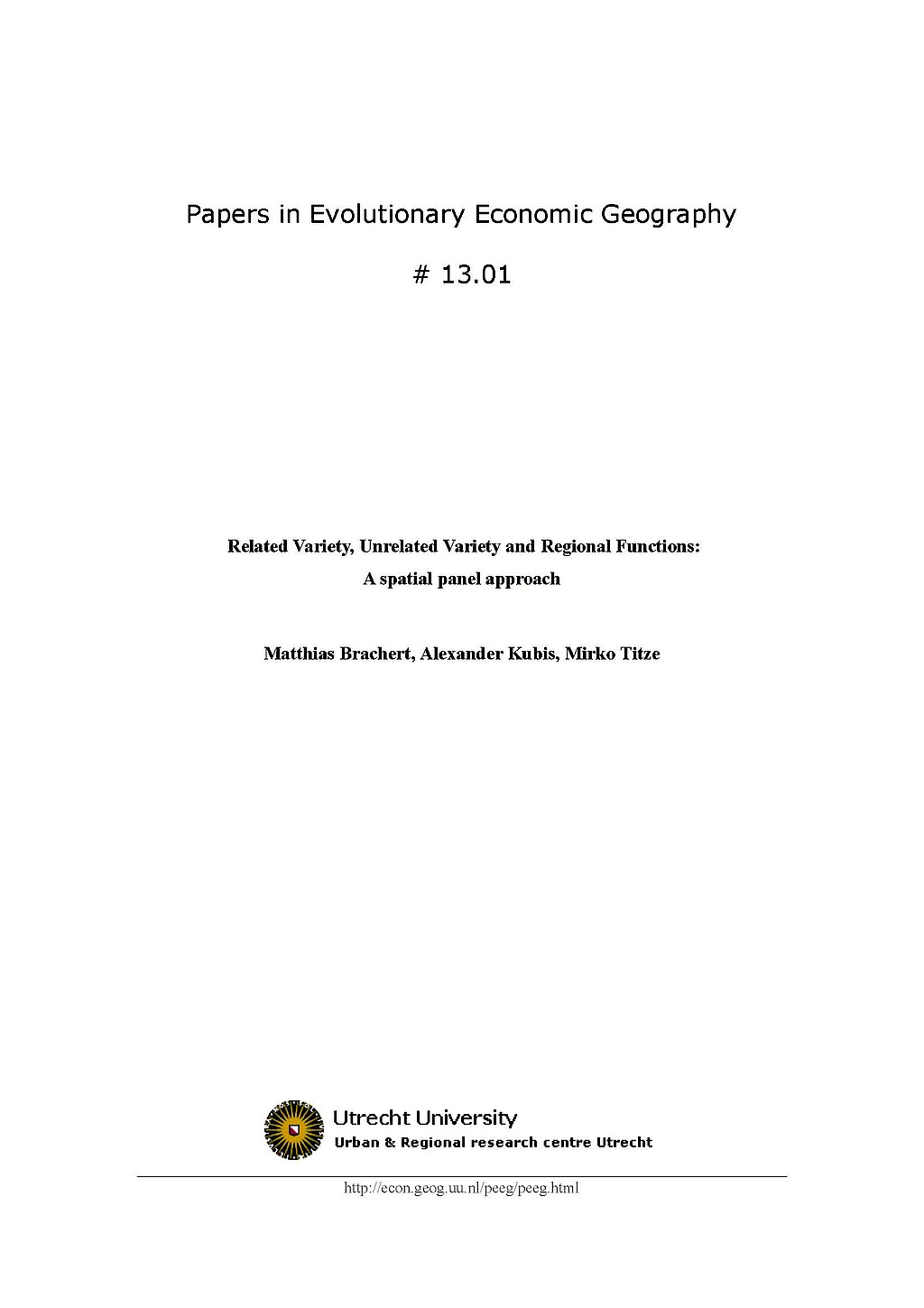
Related Variety, Unrelated Variety and Regional Functions: A spatial panel approach
in: Papers in Evolutionary Economic Geography, 2013
Abstract
The paper presents estimates for the impact of related variety, unrelated variety and the functions a region performs in the production process on regional employment growth in Germany. We argue that regions benefit from the existence of related activities that facilitate economic development. Thereby the sole reliance of the related and unrelated variety concept on standard industrial classifications (SIC) remains debatable. We offer estimations for establishing that conceptual progress can be made when the focus of analysis goes beyond solely considering industries. We develop an industry-function based approach of related and unrelated variety and test our hypothesis by the help of spatial panel approach. Our findings suggest that related variety as same as unrelated variety facilitate regional employment growth in Germany. However, the drivers behind these effects do differ. While the positive effect of related variety is driven by high degrees of relatedness in the regional “R&D” and “White-Collar”-functions, the effects of unrelated variety are spurred by “Blue Collar”-functions in this period.













